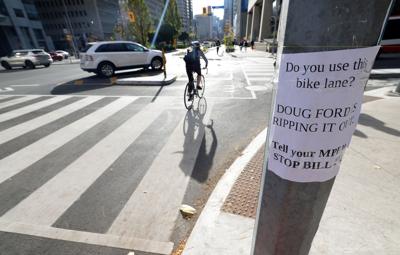Have three Canadian provinces really uncovered the ŌĆ£cheat codeŌĆØ to solving traffic congestion thatŌĆÖs eluded cities around the world? A recent obsession with bike lanes might have you wondering.
Ontario passed Bill 212 last fall, restricting municipalities from building new bike lanes and giving the province the power to remove existing ones. That legislation targets ripping out 19 km of bike lanes in ╬┌č╗┤½├Į.
Nova Scotia passed Bill 24 this spring, allowing the province to override municipal transportation decisions including bike lanes. This followed a doomed attempt by HalifaxŌĆÖs mayor to pause its bike lane plans against the will of city council.
Alberta is “actively reviewing” existing and planned bike lanes with the mayors of Calgary and Edmonton and remains coy about introducing its own legislation.
This is an anomaly. No other jurisdiction in the world has tried to systematically dictate where cities can or canŌĆÖt build bike lanes. (U.S. President Donald Trump recently mused about scrapping New York CityŌĆÖs bike lanes, but despite his affinity for frivolous executive orders, he never followed through.) Canada, meanwhile, now has three.
Yes, under our Constitution, municipalities are ŌĆ£creatures of the provinces.ŌĆØ And to date, no bike lanes have been explicitly blocked or removed. But it’s not for lack of trying.
In Ontario, a court recently dismissed the province’s claims as arbitrary and ruled that the intent to remove protected bike lanes in ╬┌č╗┤½├Į was unconstitutional, finding that it would violate section 7 Charter-protected rights to life and security of the person.
seriously question the stated purpose of the legislation. The provinceŌĆÖs own experts agree that bike lanes do not cause traffic congestion, but that removing them will put peopleŌĆÖs lives at risk.
A new shows the majority of ╬┌č╗┤½├Įnians disapprove of these removals and seven in 10 support building protected bike lanes. And nearly eight in 10 agree that the city needs to do more to protect those vulnerable road users outside of cars including cyclists. In ╬┌č╗┤½├ĮŌĆÖs mayoral byelection that saw Olivia ChowŌĆÖs victory, more than 85 per cent of voters rejected the divisive rhetoric of candidates who tried to use bike lanes as a wedge issue. To put it like former Mayor Rob Ford might recognize: the war on the war on the car is over.
While Ottawa has no direct authority over municipal bike lanes (no more than any province did before last fall), it’s now overdue that Prime Minister Mark Carney and Minister of Transport Chrystia Freeland exercise federal soft power to ensure the provinces abandon these bike lane schemes.
And if they wonŌĆÖt act voluntarily, Ottawa needs to be prepared to use tools such as publicly affirming municipalitiesŌĆÖ right to plan their own streets and tying infrastructure funding to that principle to keep those provinces from jeopardizing the collective national interest.
This isnŌĆÖt about ideology. ItŌĆÖs about geometry. We simply donŌĆÖt have enough space to keep indulging magical thinking that every person can drive for every trip.
We can reject the orthodoxy that bike lanes are a left-right issue. When Carney began serving as Governor of the Bank of England in 2012, Conservative party stalwart Boris Johnson was overseeing a historic expansion of LondonŌĆÖs cycling network as mayor.
To meet this moment facing an unprecedented trade war and economic uncertainty, a Team Canada approach must ensure cities donŌĆÖt get left behind. And that includes protecting citiesŌĆÖ authority to rebalance their streets so everyone can get home safely.
Error! Sorry, there was an error processing your request.
There was a problem with the recaptcha. Please try again.
You may unsubscribe at any time. By signing up, you agree to our and . This site is protected by reCAPTCHA and the Google and apply.
Want more of the latest from us? Sign up for more at our newsletter page.

























To join the conversation set a first and last name in your user profile.
Sign in or register for free to join the Conversation